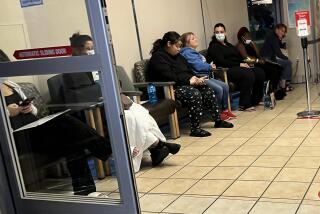Coronary Bypass Surgery: Doctors Overlooking Women, New Study Says
WASHINGTON â Men with symptoms of heart disease are 10 times more likely to be recommended for coronary bypass surgery than women with similar symptoms, according to a newly published report.
The study, carried out among 390 patients treated in New York City between July, 1982, and June, 1983, found that even after accounting for differences in age and severity of disease, men were still considered for surgery almost seven times more often than women.
âIt is an enormous, disturbing difference that cannot be explained by the distribution of heart disease in the population,â said Jonathan Tobin, assistant professor of epidemiology at New Yorkâs Albert Einstein College of Medicine and the principal author of the report. âHere is a case where social perceptions are masquerading as scientific fact. Unfortunately, sexism is just as common in medicine as it is everywhere else.â
Tobin gave several reasons for the sex bias, including âmy sense that doctors often make inaccurate assumptions about the relative contributions of men and women to society.â
Five-Year Study
He said the purpose of the continuing five-year study was to find out when physicians were most likely to recommend bypass surgery, a costly procedure that has been performed with increasing regularity over the last decade. He said the issue of sex bias emerged only after examining the data.
Heart disease is Americaâs leading killer, striking men earlier than women but affecting both in relatively equal measure, according to the National Center for Health Statistics. In 1985, more than 230,000 coronary bypass operations were performed in American hospitals, more than twice the 1980 figure. In both years, however, men received at least 70% of those operations.
According to the most recent available statistics, more than 19 million Americans said they were told by doctors they had heart disease in 1985. Of those, 9 million were men and 10 million were women. The longer life expectancy of women accounted for their greater numbers, according to the NCHS.
Medical experts cite several reasons why men receive most of the bypass operations. Patients with larger hearts and coronary arteries are more likely to respond well immediately after the surgery, and men generally have larger coronary arteries than women. Also, because they are likely to live longer, women with serious heart disease are often older and sicker than men.
Several studies in the past have reported a higher mortality rate among women than men after they receive bypass surgery. But at least one recent study has found no difference.
Seen as Not as Effective
The authors of the report found a widely held perception among doctors that the surgery simply is not as effective for women, a perception that appears not to be well supported by data. Even so, they said they were surprised to see the massive differences in the percentages of men and women recommended for bypass surgery.
The study, published in the Annals of Internal Medicine, found that women are twice as likely as men to have their symptoms--such as chest pain and shortness of breath--dismissed as something other than heart disease by their doctors.
There was also a significant difference in the reasons given by physicians for recommending further tests. With men, it was most likely to be an attempt to determine the severity of the illness. With women, it was usually an effort to confirm the presence of disease.
âThe same standards of care should apply to men and women, and they donât,â said Dr. Richard Steingart, currently director of cardiology at Winthrop University Hospital in Mineola, N.Y., and co-author of the study. âAt the very least we need better physician awareness and education.â
The study analyzed how often patients were recommended for catheterization and coronary bypass surgery after having special tests that indicate heart disease.
Catheters are used as a common road map for surgeons seeking to determine the presence and size of blocked areas in the arteries. They are inserted through the arm or groin and dye is released. The silhouette can then measure the ability of the heart to pump blood throughout the body.
In the study, only 4% of the women with strong initial signs of disease were recommended for catheterization, compared to 40% of the men.






